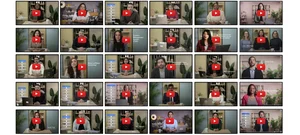Journalism 360 grant winners announced

While advances in immersive storytelling—360 video, virtual reality, augmented reality and drones—have the potential to make journalism richer and more engaging, it can be challenging for journalists to adopt and embrace these new tools. In 2016, the Google News Lab, the John S. and James L. Knight Foundation and the Online News Association created Journalism 360, a coalition of hundreds of journalists from around the world to build new skills required to tell immersive stories. Today, the coalition announced the 11 winners of its first grant challenge, which will fund projects to tackle some of the most critical challenges facing the advancement of immersive journalism: the need for better tools and trainings, the development of best practices, and new use cases.
Here’s a bit more about the winning projects:
- Aftermath VR app: New Cave Media, led by Alexey Furman in Kyiv, Ukraine.
An app that applies photogrammetry, which uses photography to measure and map objects, to recreate three-dimensional scenes of news events and narrate what happened through voiceover and archival footage. - AI-generated Anonymity in VR Journalism: University of British Columbia, led by Taylor Owen, Kate Hennessy and Steve DiPaol in Vancouver, Canada.
Helps reporters test whether an emotional connection can be maintained in immersive storytelling formats when a character’s identity is hidden. - Community and Ethnic Media Journalism 360: City University of New York, led by Bob Sacha in New York.
Makes immersive storytelling more accessible to community media (local broadcasters, public radio and TV, etc.) and ethnic media through hands-on training and access to equipment. The team also aims to produce a “how to” guide for using immersive storytelling to cover local events such as festivals. - Dataverses: Information Visualization into VR Storytelling: The Outliers Collective, led by Oscar Marin Miro in Barcelona, Spain.
Makes it easier to integrate data visualizations into immersive storytelling through a platform that includes virtual reality videos, photos and facts. For example, a user could show a map of the Earth highlighting places without water access, and link each area to a virtual reality video that explores the experience of living there. - Facing Bias: The Washington Post, led by Emily Yount in Washington, D.C.
Develops a smartphone tool that will use augmented reality to analyze a reader's facial expressions while they view images and statements that may affirm or contradict their beliefs. The aim is to give readers a better understanding of their own biases. - Spatial and Head-Locked Stereo Audio for 360 Journalism: NPR, led by Nicholas Michael in Washington, D.C.
Develops best practices for immersive storytelling audio by producing two virtual reality stories with a particular focus on sound-rich scenes. The project will explore, test and share spatial audio findings from these experiments.
- Immersive Storytelling from the Ocean Floor: MIT Future Ocean Lab, led by Allan Adams in Cambridge, Massachusetts.
Creates a camera and lighting system to produce immersive stories underwater and uncover the hidden experiences that lie beneath the ocean’s surface.
- Location-Based VR Data Visualization: Arizona State University, Cronkite School of Journalism, led by Retha Hill in Tempe, Arizona.
Helps journalists and others easily create location-based data visualizations in a virtual reality format. For example, users could explore crime statistics or education data on particular neighborhoods through data overlays on virtual reality footage of these areas.
- Voxhop by Virtual Collaboration Research Inc.: Ainsley Sutherland in Cambridge, Massachusetts.
Makes it easy to craft audio-driven virtual reality stories through a tool that would allow journalists to upload, generate or construct a three-dimensional environment and narrate the scene from multiple perspectives. For example, a reporter could construct a three-dimensional crime scene and include voiceovers detailing accounts of what transpired in the space.
- Scene VR: Northwestern University Knight Lab, led by Zach Wise in Evanston, Illinois.
Develops a tool that would make it easier for journalists and others to create virtual reality photo experiences that include interactive navigation, using their smartphone or a camera.
- The Wall: The Arizona Republic and USA TODAY Network, led by Nicole Carroll in Phoenix, Arizona.
Uses virtual reality, data and aerial video, and documentary shorts to bring the story of the proposed border wall between the United States and Mexico to life.
Over the course of the next year, the project leads will share their learnings on the Journalism 360 blog. Because this is all about building community, the recipients will also gather at the Online News Association’s annual conference in Washington, D.C. this September to discuss their projects, answer questions and share their progress. In early 2018, they will present their finished projects.
To learn more about Journalism 360, follow the blog or on Twitter. You can learn more about the Google News Lab’s work in immersive journalism on our website.






